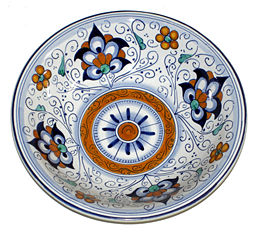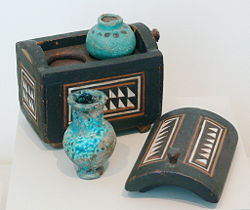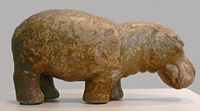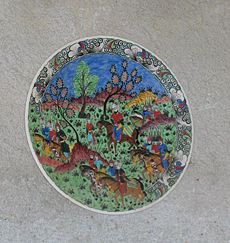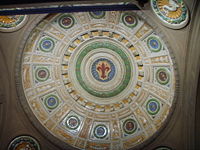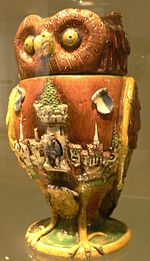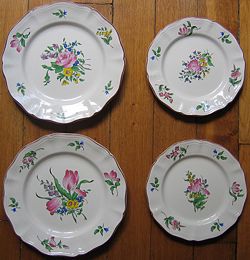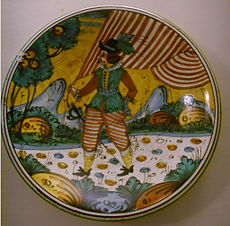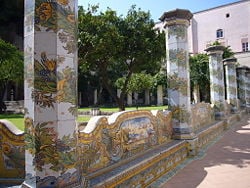Difference between revisions of "Faience" - New World Encyclopedia
({{Paid}}) |
Rosie Tanabe (talk | contribs) |
||
| (8 intermediate revisions by 4 users not shown) | |||
| Line 1: | Line 1: | ||
| − | {{ | + | {{Copyedited}}{{Images OK}}{{submitted}}{{approved}}{{Paid}} |
| − | + | [[Image:Faience Plate Traditional.jpg|thumb|260px|Fine tin-glazed earthenware ''([[maiolica]])'' in traditional pattern, made in [[Faenza]].]] | |
| − | [[Image:Faience Plate Traditional.jpg|thumb|260px|Fine tin-glazed earthenware | + | '''Faience''' or '''faïence''' is the conventional name in [[English language|English]] for fine tin-glazed [[earthenware]] on a delicate pale buff body. The invention of a pottery glaze suitable for painted decoration, by the addition of an [[stannous oxide|oxide of tin]] to the slip<ref>A clay solution of creamy consistency for coating or decorating low fired clay.</ref> of a lead glaze, was a major advance in the history of [[pottery]]. A [[kiln]] capable of producing temperatures exceeding 1000[[Celsius|° C ]] or 1832 [[Farenheit|° F]] was required to achieve this result (see pottery), which was the result of millennia of refined pottery-making traditions. |
| − | |||
| − | '''Faience''' or '''faïence''' is the conventional name in [[English language|English]] for fine tin-glazed [[earthenware]] on a delicate pale buff body. The invention of a pottery glaze suitable for painted decoration, by the addition of an [[stannous oxide|oxide of tin]] to the slip<ref>A clay solution of creamy consistency for coating or decorating low fired clay.</ref> of a lead glaze, was a major advance in the history of [[pottery]]. A [[kiln]] capable of producing temperatures exceeding 1000[[Celsius|° C ]] or 1832 [[Farenheit|° F]] was required to achieve this result (see | ||
| − | |||
| − | |||
| + | The invention of the mature form of the technique seems to have been made in [[Iran]] or the Middle East before the ninth century C.E., although archaeologists now include the faience-like pottery found in [[ancient Egypt]]. Today, faience is usually made in [[France]], [[Germany]], [[Spain]], and [[Scandinavia]], and [[Italy]], where it is called ''maiolica''. Similarly, [[Delftware]] is tin-glazed earthenware made first in early seventeenth century at Delft, [[Holland]]. Dutch potters later brought this art of tin glazing to England. The name delftware now applies to wares manufactured in The [[Netherlands]] and [[England]]. | ||
| + | {{toc}} | ||
Technically, lead-glazed earthenware, such as the French sixteenth-century [[Saint-Porchaire ware]], does not properly qualify as faience, but the distinction is not usually maintained. | Technically, lead-glazed earthenware, such as the French sixteenth-century [[Saint-Porchaire ware]], does not properly qualify as faience, but the distinction is not usually maintained. | ||
==Ancient "faience"== | ==Ancient "faience"== | ||
[[Image:Cosmetics case Egypt.jpg|thumb|250px|Egyptian cosmetic case]] | [[Image:Cosmetics case Egypt.jpg|thumb|250px|Egyptian cosmetic case]] | ||
| − | The earliest "faience" pieces, though not conforming entirely to the modern definition, were finely glazed ceramic beads found in [[Pre-dynastic Egypt|Egypt]] as early as | + | The earliest "faience" pieces, though not conforming entirely to the modern definition, were finely glazed ceramic beads found in [[Pre-dynastic Egypt|Egypt]] as early as 4000 B.C.E. and at sites in the [[Indus Valley Civilization]]. In the Early Dynastic Period (3000-2000 B.C.E.) the technique was used for the making of small [[animal]] and [[human]] figures, the most striking were the blue-glazed hippopotamus figures of the Middle Kingdom. Faience tiles, chiefly for wall decoration, were found in the subterranean chambers of the Step Pyramid and other buildings. |
[[Image:Hippopotamus Egypt fayence Berlin.jpg|thumb|200px|left|Egyptian Hoppopotamus]] | [[Image:Hippopotamus Egypt fayence Berlin.jpg|thumb|200px|left|Egyptian Hoppopotamus]] | ||
| Line 17: | Line 15: | ||
Highly developed amulets and divine figurines in faience were made in the Late Dynastic Period. | Highly developed amulets and divine figurines in faience were made in the Late Dynastic Period. | ||
[[Image:Shawabti of Lady Sati.jpg|thumb|100px|Shawabti of Lady Sati]] | [[Image:Shawabti of Lady Sati.jpg|thumb|100px|Shawabti of Lady Sati]] | ||
| − | In this period in particular, the faience glaze process was highly developed, and many figures reveal a high standard of modeling and perfection of glazing. The vast quantities of funerary ''[[ushabti]]'' | + | In this period in particular, the faience glaze process was highly developed, and many figures reveal a high standard of modeling and perfection of glazing. The vast quantities of funerary ''[[ushabti]]'' figurines were often examples of faience. |
| − | In the New Kingdom (1539–1075 | + | In the New Kingdom (1539–1075 B.C.E.), during the reigns of [[Amenhotep III]] and his successors, tiles with floral designs were used in houses and palaces. During the nineteenth and twentieth dynasties, the royal palaces at Per Ramessu (modern Qantir), Tell al-Yahudiyah, and Madinat Habu were decorated with vibrant polychrome tiles, some bearing figures of captive foreigners. Other figures were made to resemble the tomb owner in the form of a mummy bearing the owner's name. |
==Faience in the Middle Ages== | ==Faience in the Middle Ages== | ||
| + | [[Image:Durlacher Fayence rem 2.jpg|thumb|250px|left|Durlacher faience]] | ||
[[Image:Turkey.Gülşehir005.jpg|thumb|230px|Turkish faience plate]] | [[Image:Turkey.Gülşehir005.jpg|thumb|230px|Turkish faience plate]] | ||
[[Image:Poste centrali firenze cupoletta.JPG|thumb|200px|Palazzi di Firenze Faience Cupola]] | [[Image:Poste centrali firenze cupoletta.JPG|thumb|200px|Palazzi di Firenze Faience Cupola]] | ||
Artists in [[Iran]] or the Middle East in the early ninth century C.E. first crafted faience pieces which follow the modern definition of tin-glazed [[earthenware]] on a delicate pale buff body. The necessary kiln temperature was always a factor in production of such ware. | Artists in [[Iran]] or the Middle East in the early ninth century C.E. first crafted faience pieces which follow the modern definition of tin-glazed [[earthenware]] on a delicate pale buff body. The necessary kiln temperature was always a factor in production of such ware. | ||
| − | In the later ninth century, the Moors brought the technique of tin-glazed earthenware to [[Al-Andalus]] in today's [[Spain]], where the art of metallic glazes was perfected. There, tin-glazed ware was produced from the twelfth to the sixteenth centuries and was called ''Hispano-Moresque'' ware. From Andalusia it was exported, either directly or via the [[Balearic Islands]] to Italy. There, locally produced tin-glazed earthenwares replaced the Spanish ware, beginning in the fourteenth century. Production reached a peak in the late fifteenth and early sixteenth centuries, represented by the Italian faience called [[Majolica]].<ref>"Majolica" derives from [[Majorca]], an early depot for the re-export of tin-glazed earthenware to Italy.</ref> | + | In the later ninth century, the [[Moors]] brought the technique of tin-glazed earthenware to [[Al-Andalus]] in today's [[Spain]], where the art of metallic glazes was perfected. There, tin-glazed ware was produced from the twelfth to the sixteenth centuries and was called ''Hispano-Moresque'' ware. From Andalusia it was exported, either directly or via the [[Balearic Islands]] to Italy. There, locally produced tin-glazed earthenwares replaced the Spanish ware, beginning in the fourteenth century. Production reached a peak in the late fifteenth and early sixteenth centuries, represented by the Italian faience called [[Majolica]].<ref>"Majolica" derives from [[Majorca]], an early depot for the re-export of tin-glazed earthenware to Italy.</ref> This type of Spanish pottery owed much to its [[Moorish]] inheritance. |
The name ''faience'' is simply the French name for the town of [[Faenza]], in the [[Romagna]] near [[Ravenna]], Italy, where a painted ''majolica'' ware on a clean, opaque pure-white ground, was produced for export as early as the fifteenth century. | The name ''faience'' is simply the French name for the town of [[Faenza]], in the [[Romagna]] near [[Ravenna]], Italy, where a painted ''majolica'' ware on a clean, opaque pure-white ground, was produced for export as early as the fifteenth century. | ||
| Line 32: | Line 31: | ||
==French and northern European faïence== | ==French and northern European faïence== | ||
[[Image:Eulenpokal-Stadt-Schaffhausen-Fayence-16Jhr.jpg|thumb|left|150px| German faienceware]] | [[Image:Eulenpokal-Stadt-Schaffhausen-Fayence-16Jhr.jpg|thumb|left|150px| German faienceware]] | ||
| − | The first northerners to imitate the tin-glazed earthenwares being imported from Italy and/or Spain were the [[Netherlands|Dutch]]. [[Delftware]] is a kind of faience, made at potteries around Delft in [[Holland]], characteristically decorated in blue on white, in imitation of the blue-and-white [[porcelain]] that was imported from [[China]] in the early [[ | + | The first northerners to imitate the tin-glazed earthenwares being imported from Italy and/or Spain were the [[Netherlands|Dutch]]. [[Delftware]] is a kind of faience, made at potteries around Delft in [[Holland]], characteristically decorated in blue on white, in imitation of the blue-and-white [[porcelain]] that was imported from [[China]] in the early [[sixteenth century]], but it quickly developed its own recognizable Dutch décor. |
| − | The [[30 Years War]] drove many potters out of Holland to Germany as the majority of them were | + | The [[30 Years War]] drove many potters out of Holland to Germany as the majority of them were Protestants. Dutch potters in northern (and Protestant) Germany established German centers of faience: the first manufacturer's in Germany were opened at [[Hanau]] (1661) and Heusenstamm (1662), and soon moved to nearby [[Frankfurt-am-Main]]. |
| − | [[Image:Faience-luneville-saint-clement.jpg|thumb|right|250px|Faience of [[Lunéville]]]]In France, centers of faience manufacturing developed from just prior to the [[ | + | [[Image:Faience-luneville-saint-clement.jpg|thumb|right|250px|Faience of [[Lunéville]]]]In France, centers of faience manufacturing developed from just prior to the [[eighteenth century]] and was led in 1690 by [[Quimper]] in Brittany, which today possesses an interesting [[museum]] devoted to faience, and followed by [[Rouen]], [[Strasbourg]] and Lunéville. |
The products of faience factories, rarely marked, are identified by the usual methods of ceramic quality: the character of the [[Body (ceramic)|body]], the character and palette of the [[ceramic glaze|glaze]], and the style of decoration, ''faïence blanche''' being left in its undecorated fired white slip. ''Faïence parlante'' bears mottoes often on decorative labels or banners. Wares for [[apothecary]] use bear the names of their intended contents, generally in Latin and often so abbreviated to be unrecognizable to the untutored eye. Mottoes of fellowships and associations became popular in the eighteenth century, leading to the ''Faïence patriotique'' that was a specialty of the years of the [[French Revolution]]. | The products of faience factories, rarely marked, are identified by the usual methods of ceramic quality: the character of the [[Body (ceramic)|body]], the character and palette of the [[ceramic glaze|glaze]], and the style of decoration, ''faïence blanche''' being left in its undecorated fired white slip. ''Faïence parlante'' bears mottoes often on decorative labels or banners. Wares for [[apothecary]] use bear the names of their intended contents, generally in Latin and often so abbreviated to be unrecognizable to the untutored eye. Mottoes of fellowships and associations became popular in the eighteenth century, leading to the ''Faïence patriotique'' that was a specialty of the years of the [[French Revolution]]. | ||
| Line 44: | Line 43: | ||
==Faïence revival== | ==Faïence revival== | ||
[[Image:Ceramica di Montelupo (riproduzione).JPG|thumb|230px| Majolica plate]] | [[Image:Ceramica di Montelupo (riproduzione).JPG|thumb|230px| Majolica plate]] | ||
| − | In the 1870s, the [[Aesthetic movement]], notably in Britain, rediscovered the robust charm of faience, and the large porcelain factories marketed revived faience, such as the "Majolica ware" of [[Mintons Ltd|Minton]] and of [[Wedgwood]]. | + | In the 1870s, the [[Aesthetic movement]], notably in [[Great Britain|Britain]], rediscovered the robust charm of faience, and the large porcelain factories marketed revived faience, such as the "Majolica ware" of [[Mintons Ltd|Minton]] and of [[Wedgwood]]. |
Many centers of traditional manufacture are recognized, even the work of some individual ''ateliers'' (an artist, artisan, or designer with their own workshop). | Many centers of traditional manufacture are recognized, even the work of some individual ''ateliers'' (an artist, artisan, or designer with their own workshop). | ||
| Line 50: | Line 49: | ||
==Partial list of faience manufacturers== | ==Partial list of faience manufacturers== | ||
*England: [[Faience fine]] (imported into France) | *England: [[Faience fine]] (imported into France) | ||
| − | [[Image:Napoli s Chiara chiostro - maioliche 1040860.JPG|thumb|250px|Pillars and benches in faience glaze in Napoli, Italy]] | + | [[Image:Napoli s Chiara chiostro - maioliche 1040860.JPG|thumb|250px|Pillars and benches in faience glaze in Napoli, Italy.]] |
*France: [[Aprey faience]], [[Gien faience]], [[Lyon faience]], [[Lunéville faience]], [[Marseille faience]], [[Moustiers faience]], [[Nevers faience]], [[Quimper faience]], [[Saint-Porchaire ware]] | *France: [[Aprey faience]], [[Gien faience]], [[Lyon faience]], [[Lunéville faience]], [[Marseille faience]], [[Moustiers faience]], [[Nevers faience]], [[Quimper faience]], [[Saint-Porchaire ware]] | ||
*Germany: [[:de:Abtsbessingen|Abtsbessingen faience]], [[Nürnberg faience]], [[Öttingen–Schrattenhofen faience]], [[Schleswig faience]], [[Stockelsdorf faience]] - [[:de:Stockelsdorfer Fayencemanufaktur]], [[Stralsund faience]] - [[:de:Stralsunder Fayencenmanufaktur]] | *Germany: [[:de:Abtsbessingen|Abtsbessingen faience]], [[Nürnberg faience]], [[Öttingen–Schrattenhofen faience]], [[Schleswig faience]], [[Stockelsdorf faience]] - [[:de:Stockelsdorfer Fayencemanufaktur]], [[Stralsund faience]] - [[:de:Stralsunder Fayencenmanufaktur]] | ||
| − | |||
*Italy: [[Savona faience]], [[Turin faience]] | *Italy: [[Savona faience]], [[Turin faience]] | ||
*Scandinavia: [[Aluminia faience]] (Denmark), [[Rörstrand faience]] (Sweden), [[Strålsund faience]] (Sweden, closed 1792) | *Scandinavia: [[Aluminia faience]] (Denmark), [[Rörstrand faience]] (Sweden), [[Strålsund faience]] (Sweden, closed 1792) | ||
| Line 63: | Line 61: | ||
==References== | ==References== | ||
| − | * Cleveland Museum of Art ( | + | * Cleveland Museum of Art (Author), Rhode Island School of Design Museum of Art (Author), Kimbell Art Museum (Author), Florence Dunn Friedman, Georgina Borromeo, Mimi Leveque (eds.). ''Gifts of the Nile: ancient Egyptian faience''. New York: Thames and Hudson, 1998. |
| − | * Giacomotti, Jeanne. ''French faience''. Universe Books, 1963. OCLC 1071290 | + | * Giacomotti, Jeanne. ''French faience''. Universe Books, 1963. {{OCLC|1071290}} |
| − | * Gorman, Jessica. ''Articles - Flattery for Faience - Imitating ancient materials reveals lost manufacturing secrets'' | + | * Gorman, Jessica. ''Articles - Flattery for Faience - Imitating ancient materials reveals lost manufacturing secrets''. Washington, D.C.: Science Service, 1966, Publication: Science news. 161 no. 3 (2002):45. {{OCLC|93341743}} |
| − | * Scavizzi, Giuseppe. ''Maiolica, Delft and Faïence'' | + | * Scavizzi, Giuseppe. ''Maiolica, Delft and Faïence''. Feltham and Hamlyn, 1970. |
==External links== | ==External links== | ||
| − | + | All links retrieved March 23, 2024. | |
| − | + | ||
| − | + | * [http://www.beerstein.net/articles/s9606a.htm A Very Concise History of Faience and a Listing of German Faience Factories] ''www.beerstein.net'' | |
| − | * [http://www.beerstein.net/articles/s9606a.htm German | ||
[[Category:Art, music, literature, sports and leisure]] | [[Category:Art, music, literature, sports and leisure]] | ||
{{credit|111422631}} | {{credit|111422631}} | ||
Latest revision as of 00:28, 25 March 2024
Faience or faïence is the conventional name in English for fine tin-glazed earthenware on a delicate pale buff body. The invention of a pottery glaze suitable for painted decoration, by the addition of an oxide of tin to the slip[1] of a lead glaze, was a major advance in the history of pottery. A kiln capable of producing temperatures exceeding 1000° C or 1832 ° F was required to achieve this result (see pottery), which was the result of millennia of refined pottery-making traditions.
The invention of the mature form of the technique seems to have been made in Iran or the Middle East before the ninth century C.E., although archaeologists now include the faience-like pottery found in ancient Egypt. Today, faience is usually made in France, Germany, Spain, and Scandinavia, and Italy, where it is called maiolica. Similarly, Delftware is tin-glazed earthenware made first in early seventeenth century at Delft, Holland. Dutch potters later brought this art of tin glazing to England. The name delftware now applies to wares manufactured in The Netherlands and England.
Technically, lead-glazed earthenware, such as the French sixteenth-century Saint-Porchaire ware, does not properly qualify as faience, but the distinction is not usually maintained.
Ancient "faience"
The earliest "faience" pieces, though not conforming entirely to the modern definition, were finely glazed ceramic beads found in Egypt as early as 4000 B.C.E. and at sites in the Indus Valley Civilization. In the Early Dynastic Period (3000-2000 B.C.E.) the technique was used for the making of small animal and human figures, the most striking were the blue-glazed hippopotamus figures of the Middle Kingdom. Faience tiles, chiefly for wall decoration, were found in the subterranean chambers of the Step Pyramid and other buildings.
Highly developed amulets and divine figurines in faience were made in the Late Dynastic Period.
In this period in particular, the faience glaze process was highly developed, and many figures reveal a high standard of modeling and perfection of glazing. The vast quantities of funerary ushabti figurines were often examples of faience.
In the New Kingdom (1539–1075 B.C.E.), during the reigns of Amenhotep III and his successors, tiles with floral designs were used in houses and palaces. During the nineteenth and twentieth dynasties, the royal palaces at Per Ramessu (modern Qantir), Tell al-Yahudiyah, and Madinat Habu were decorated with vibrant polychrome tiles, some bearing figures of captive foreigners. Other figures were made to resemble the tomb owner in the form of a mummy bearing the owner's name.
Faience in the Middle Ages
Artists in Iran or the Middle East in the early ninth century C.E. first crafted faience pieces which follow the modern definition of tin-glazed earthenware on a delicate pale buff body. The necessary kiln temperature was always a factor in production of such ware.
In the later ninth century, the Moors brought the technique of tin-glazed earthenware to Al-Andalus in today's Spain, where the art of metallic glazes was perfected. There, tin-glazed ware was produced from the twelfth to the sixteenth centuries and was called Hispano-Moresque ware. From Andalusia it was exported, either directly or via the Balearic Islands to Italy. There, locally produced tin-glazed earthenwares replaced the Spanish ware, beginning in the fourteenth century. Production reached a peak in the late fifteenth and early sixteenth centuries, represented by the Italian faience called Majolica.[2] This type of Spanish pottery owed much to its Moorish inheritance.
The name faience is simply the French name for the town of Faenza, in the Romagna near Ravenna, Italy, where a painted majolica ware on a clean, opaque pure-white ground, was produced for export as early as the fifteenth century.
French and northern European faïence
The first northerners to imitate the tin-glazed earthenwares being imported from Italy and/or Spain were the Dutch. Delftware is a kind of faience, made at potteries around Delft in Holland, characteristically decorated in blue on white, in imitation of the blue-and-white porcelain that was imported from China in the early sixteenth century, but it quickly developed its own recognizable Dutch décor.
The 30 Years War drove many potters out of Holland to Germany as the majority of them were Protestants. Dutch potters in northern (and Protestant) Germany established German centers of faience: the first manufacturer's in Germany were opened at Hanau (1661) and Heusenstamm (1662), and soon moved to nearby Frankfurt-am-Main.
In France, centers of faience manufacturing developed from just prior to the eighteenth century and was led in 1690 by Quimper in Brittany, which today possesses an interesting museum devoted to faience, and followed by Rouen, Strasbourg and Lunéville.
The products of faience factories, rarely marked, are identified by the usual methods of ceramic quality: the character of the body, the character and palette of the glaze, and the style of decoration, faïence blanche' being left in its undecorated fired white slip. Faïence parlante bears mottoes often on decorative labels or banners. Wares for apothecary use bear the names of their intended contents, generally in Latin and often so abbreviated to be unrecognizable to the untutored eye. Mottoes of fellowships and associations became popular in the eighteenth century, leading to the Faïence patriotique that was a specialty of the years of the French Revolution.
In the course of the later eighteenth century, cheap porcelain and creamware (white English lead-glazed earthenware) took over the market for refined faience and even beer steins. In the early nineteenth century, kiln development allowed fine stoneware—to be fired so hot that the unglazed body vitrifies—into a much harder ware.[3] This became all the rage thus causing the last of the traditional makers' ateliers to close. At the low end of the market, local factories continued to supply regional markets with coarse and simple wares.
Faïence revival
In the 1870s, the Aesthetic movement, notably in Britain, rediscovered the robust charm of faience, and the large porcelain factories marketed revived faience, such as the "Majolica ware" of Minton and of Wedgwood.
Many centers of traditional manufacture are recognized, even the work of some individual ateliers (an artist, artisan, or designer with their own workshop).
Partial list of faience manufacturers
- England: Faience fine (imported into France)
- France: Aprey faience, Gien faience, Lyon faience, Lunéville faience, Marseille faience, Moustiers faience, Nevers faience, Quimper faience, Saint-Porchaire ware
- Germany: Abtsbessingen faience, Nürnberg faience, Öttingen–Schrattenhofen faience, Schleswig faience, Stockelsdorf faience - de:Stockelsdorfer Fayencemanufaktur, Stralsund faience - de:Stralsunder Fayencenmanufaktur
- Italy: Savona faience, Turin faience
- Scandinavia: Aluminia faience (Denmark), Rörstrand faience (Sweden), Strålsund faience (Sweden, closed 1792)
Notes
- ↑ A clay solution of creamy consistency for coating or decorating low fired clay.
- ↑ "Majolica" derives from Majorca, an early depot for the re-export of tin-glazed earthenware to Italy.
- ↑ Melting into a glass-like consistency, bonding all elements on a cellular level resulting in a much stronger piece.
ReferencesISBN links support NWE through referral fees
- Cleveland Museum of Art (Author), Rhode Island School of Design Museum of Art (Author), Kimbell Art Museum (Author), Florence Dunn Friedman, Georgina Borromeo, Mimi Leveque (eds.). Gifts of the Nile: ancient Egyptian faience. New York: Thames and Hudson, 1998.
- Giacomotti, Jeanne. French faience. Universe Books, 1963. OCLC 1071290
- Gorman, Jessica. Articles - Flattery for Faience - Imitating ancient materials reveals lost manufacturing secrets. Washington, D.C.: Science Service, 1966, Publication: Science news. 161 no. 3 (2002):45. OCLC 93341743
- Scavizzi, Giuseppe. Maiolica, Delft and Faïence. Feltham and Hamlyn, 1970.
External links
All links retrieved March 23, 2024.
Credits
New World Encyclopedia writers and editors rewrote and completed the Wikipedia article in accordance with New World Encyclopedia standards. This article abides by terms of the Creative Commons CC-by-sa 3.0 License (CC-by-sa), which may be used and disseminated with proper attribution. Credit is due under the terms of this license that can reference both the New World Encyclopedia contributors and the selfless volunteer contributors of the Wikimedia Foundation. To cite this article click here for a list of acceptable citing formats.The history of earlier contributions by wikipedians is accessible to researchers here:
The history of this article since it was imported to New World Encyclopedia:
Note: Some restrictions may apply to use of individual images which are separately licensed.
